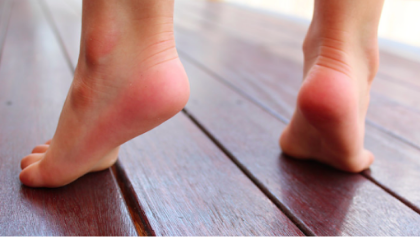Toe Walking and Treatment Methods
What is toe walking?
Toe walking is a walking or gait pattern where a child is on their tip toes without their heels touching the ground for part or all of their gait cycle. Toe walking can vary in its severity and presentation. Some cases may have heels raised very high off the ground, while other cases may look like an extra “bounciness” in the step. While some children walk on toes intermittently, especially when learning to walk, a child who is on toes for most or all of their time walking (>50% of their day) typically requires treatment to resolve and improve their pattern.
What causes toe walking?

Many children that toe walk are considered to be “idiopathic toe walkers.” This is a term used to describe toe walking that arises spontaneously for which the cause is unknown. There are some hypotheses regarding toe walking in children and why they may develop this gait pattern. These are below:
Sensory processing differences
This issue is sometimes seen in children who have difficulty processing information from their surroundings. These children often have trouble knowing where their bodies are in space. Walking on toes can give more sensory input to the body as it increases compression in the joints of the ankle, knee and hip as well as pressure receptors in the foot. This provides the child with a more comfortable sense of their body’s relationship to the ground. Sometimes, children with frequent ear infections or poor vestibular systems can exhibit some of this sensory processing difficulty, which can also alter their gait patterning.
Shortened muscles
Shortened or tight muscles and tendons can cause toe walking. If a child has a shortened heel cord, or Achilles tendon, and tight calf muscles, they may walk up on their toes. They do this because they do not have enough motion in their ankle to walk with a flat foot. Shortened muscles can also be a result of toe walking. If a child is toe walking for other reasons and it is left untreated, the muscles and tendons will shorten. Therefore, over time it will perpetuate the toe walking. Children with tight ankle muscles also exhibit a wider stance with legs rotated out when are standing in one place. They could report that they “can’t stand still.” They may also complain of knee or ankle pain with excessively tight muscles.
Weakness
Weakness in gluts, hamstrings, core, and the small muscles in the foot can contribute to toe walking. Children with weakness may toe walk to compensate for their weak muscles. Toe walking, or locking out your ankles and knees into more extension, can take some of the work away from weaker muscles. This allow children to “lock out” at the end range of their joints. Over time, this can lead to decreased endurance in play and prolonged walking. These children will often complain of being tired early on or want carried or stroller rides more often.
Neurological differences
Children with neurological differences, such as cerebral palsy, may be toe walkers. This can be due to increased muscle tone, spasticity, sensory processing difficulties, weakness, and/or other causes.
How is toe walking treated?
In conclusion, the treatment for toe walking depends on the underlying cause. A physical therapist will assist in determining what course of treatment is appropriate. Treatment strategies may include stretching, orthotics, strengthening exercises. Also, casting, balance training, gait training, and sensory interventions will be helpful. If you are concerned about your child’s toe walking, you can set up an evaluation with one of our experienced physical therapists by calling 773-687-9241 or emailing us at info@cptwc.com


